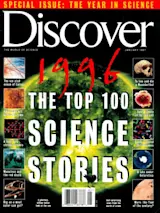Antimatter is old hat to physicists. After all, it was way back in 1933 when they discovered the first antiparticles--exact duplicates of ordinary particles except that they have an opposite electric charge. Since it usually takes only a few millionths of a second for antimatter particles to come into contact with their matter counterparts, thus annihilating themselves in tiny bursts of energy, physicists have concentrated on finding ways to make them sit still long enough to do something interesting with them. In particular, they have been trying for 15 years to combine an antiproton with an antielectron to form an antihydrogen atom.
Last January a team led by Walter Oelert of the Institute for Nuclear Physics in Jülich, Germany, announced that it had made nine atoms of antihydrogen--without first having to slow down the particles. The researchers used a particle accelerator at cern, the European Laboratory for Particle Physics in Geneva, to produce a beam of antiprotons, and then passed them through xenon gas. Whenever an antiproton collided with a xenon atom, it produced an antielectron, or positron. Since positrons are electrically attracted to antiprotons in the beam, every so often two of the particles would combine to form an antihydrogen atom.
The trick was to get a pair of particles moving at roughly the same speed and direction. We produce positrons that have all sorts of velocities, says Oelert. Once in a while one will have the same velocity as the antiprotons, and that’s when they combine. Because antihydrogen atoms are electrically neutral (the positron’s positive charge cancels the antiproton’s negative charge), the ones Oelert made were no longer confined to the accelerator’s ring-shaped electromagnetic field and went careening off into a wall of silicon. On impact, they once again separated into particles and were annihilated, releasing a characteristic burst of radiation that was picked up by a detector.
Since Oelert’s technique destroys the antihydrogen atoms virtually as soon as it creates them, it won’t help answer some of the fundamental questions about antimatter: why it seems to be so rare in the universe, for instance, and whether it is a true mirror image of matter or different in some subtle way. For that, Oelert is teaming up with physicist Gerald Gabrielse of Harvard, who, as the year ended, was trying to create relatively slow moving antihydrogen at cern. Gabrielse’s plan was to slow and trap antiprotons with magnets, and slow the positrons (derived from radioactive cobalt) by passing them through a tungsten crystal. Eventually he hopes to probe antiatoms with laser beams as they float lazily in a magnetic trap. When you have so little antihydrogen, you don’t want to be chasing it around the laboratory, explains Gabrielse. You want it to sit there so you can look at it.














